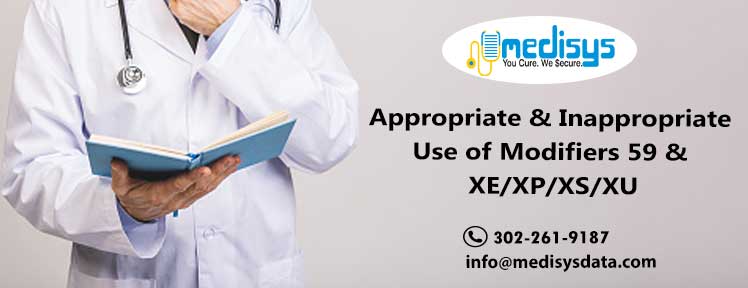Definition of Modifier 59
The CPT Manual defines modifier 59 as Distinct Procedural Service: Under certain circumstances, it may be necessary to indicate that a procedure or service was distinct or independent from other non-E/M (Evaluation/Management) services performed on the same day. Modifier 59 is used to identify procedures/services, other than E/M services, that are not normally reported together, but are appropriate under the circumstances. Documentation must support a different session, different procedure or surgery, different site or organ system, separate incision/excision, separate lesion, or separate injury (or area of injury in extensive injuries) not ordinarily encountered or performed on the same day by the same individual. However, when another already established modifier is appropriate, it should be used rather than modifier 59. Only if no more descriptive modifier is available, and the use of modifier 59 best explains the circumstances, should modifier 59 be used.
Definition of Modifier XE/XP/XS/XU
Modifier XE
Separate Encounter, a service that is distinct because it occurred during a separate encounter. Only use XE to describe separate encounters on the same date of service.
Modifier XS
Separate Structure, a service that is distinct because it was performed on a separate organ/ structure.
Modifier XP
Separate Practitioner, a service that is distinct because it was performed by a different practitioner.
Modifier XU
Unusual Non-Overlapping Service, the use of a service that is distinct because it does not overlap usual components of the main service.
Appropriate & Inappropriate Use of Modifiers
Using modifiers 59 or –XS properly for different anatomic sites during the same encounter only when procedures which aren’t ordinarily performed or encountered on the same day are performed on different organs, or different anatomic regions, or in limited situations on different, non-contiguous lesions in different anatomic regions of the same organ. Modifiers 59 or –XS are for surgical procedures, non-surgical therapeutic procedures, or diagnostic procedures. From an NCCI program perspective, the definition of different anatomic sites includes different organs or, in certain instances, different lesions in the same organ.
Only use modifiers 59 or -XE if no other modifier more properly describes the relationship of the 2 procedure codes. Another common use of modifiers 59 or –XE is for surgical procedures, non-surgical therapeutic procedures, or diagnostic procedures that are performed during different patient encounters on the same day that can’t be described by one of the more specific NCCI PTP-associated modifiers.
Don’t use modifiers 59 or –XU just because the code descriptors of the 2 codes are different. One of the common misuses of modifier 59 relates to the part of the definition of modifier 59 allowing its use to describe a “different procedure or surgery.” The code descriptors of the 2 codes of a code pair edit describe different procedures, even though they may overlap. Don’t report the 2 codes together if they’re performed at the same anatomic site and same patient encounter, because they aren’t considered “separate and distinct.” Don’t use modifiers 59 or –XU to bypass a PTP edit based on the 2 codes being “different procedures.” However, if you perform 2 procedures at separate anatomic sites or at separate patient encounters on the same date of service, you may use modifiers 59 or –X{ES} to show that they’re different procedures on that date of service. Also, there may be limited circumstances sometimes identified in the National Correct Coding Initiative Policy Manual for Medicare services when you may report the 2 codes of an edit pair together with modifiers 59 or –X{ES} when performed at the same patient encounter or at the same anatomic site.
There are 3 other limited situations where you may report 2 services as separate and distinct because they’re separated in time and describe non-overlapping services even though they may occur during the same encounter.
- Using modifiers 59 or –XE properly for 2 services described by timed codes provided during the same encounter only when they are performed one after another. There’s an appropriate use for modifier 59 that’s applicable only to codes for which the unit of service is a measure of time. If you provide 2 timed services in time periods that are separate and distinct and aren’t mingled with each other (that is, you complete one service before the next service begins), you may use modifiers 59 or –XE to identify the services.
- Using modifiers 59 or –XU properly for a diagnostic procedure which is performed before a therapeutic procedure only when the diagnostic procedure is the basis for performing the therapeutic procedure. When you perform a diagnostic procedure before a surgical procedure or non-surgical therapeutic procedure and it’s the basis on which you decide to perform the surgical procedure or non-surgical therapeutic procedure.
- Using modifiers 59 or –XU properly for a diagnostic procedure which occurs after a completed therapeutic procedure only when the diagnostic procedure isn’t a common, expected, or necessary follow-up to the therapeutic procedure. When a diagnostic procedure follows the surgical procedure or non-surgical therapeutic procedure.
We shared appropriate & inappropriate use of modifiers 59 & XE/XP/XS/XU for your reference only, for detailed understanding of these modifiers with examples, you can refer MLN document. Medisys Data Solutions is a leading medical billing company providing complete assistance in medical billing and coding. To know more about our billing and coding services, contact us at info@medisysdata.com/ 302-261-9187.












